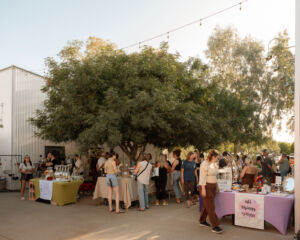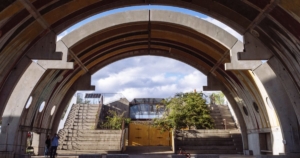Although Parkinson’s disease makes the body difficult to move, an art show created by Phoenix residents is evidence that the disease is not stopping them from expressing their creative side.
The Muhammad Ali Parkinson Center has hosted an Expressive Arts Program for about 10 years. In this program the artists go to five session workshops, in English and/or Spanish, and paint using tools that work with their motor challenges. Such tools include brushes, stencils and flowers. The program welcomes those with Parkinson’s disease, caregivers and family members.
The center holds eight workshops all year long and the art is then shown at the Bruce Florence Parkinson Annual Juried Art Show. A competition is held for the top three paintings and there is an opportunity for other paintings to have an honorable mention.
According to Claudia Martinez, the Hispanic Outreach Coordinator at the center, the art show and workshops help those who have Parkinson’s to stay motivated.
“Sometimes chronic diseases like Parkinson’s take away a lot from people,” Martinez said. “We need to be able to create avenues for them to keep enjoying life.”
According to Martinez, participation for the art show is opened to people in the community who have Parkinson’s disease and their caretakers. However, they still have to go through an application process.
“Everyone who participates in the workshops or anyone who belongs to Arizona community and has Parkinson’s is able to enter the art show,” Martinez said. “There is a process where they need to fill out an application form, and then we have a committee that goes over all the submissions and then people get accepted to the show.”
For a second time, Trinity Episcopal Cathedral was host for the art show on November 1.
“They might have a disease that other people might think they couldn’t do it,” said Manny Burrel, from the Olney Gallery at the Cathedral. “So, it’s rewarding to give them the opportunity to show [the art] in a professional gallery. At Trinity Cathedral we pride ourselves in welcoming diversity to all of our art gallery shows.”
The event showcased almost 60 pieces and had about 20 to 30 artists in attendance. The art was for sale and half of the proceeds went to the artists and the other half was given to Trinity Episcopal Cathedral.
Carlos Rivera, the third-place recipient, said being a part of this show has helped him find something to do after learning he was diagnosed with Parkinson’s.
“I never painted before,” Rivera said. “It was not until I learned that I had Parkinson’s that I joined the workshops and started to paint. You have to learn to keep going because you never know what can happen next. Today, I realized that I am good, and I can do this.”
The art show also had the Arizona School for the Arts Percussion Ensemble, Muhammed Ali Parkinson Center Choir, Driftwood Quintet, and Arizona State University Voice students sing in English and Spanish. The groups were mostly made up of people with Parkinson’s and their caregivers.
The purpose of the art show is to showcase the art made by those with Parkinson’s disease, but it also welcomes other communities.
“The idea is that the show is opened to everyone,” Martinez said. “It’s not a show just for people with Parkinson’s. It’s a show that is part of First Fridays and everyone in the community is invited. And I think that’s a beautiful way of raising awareness of Parkinson’s disease.”
According to Martinez, this is the best option to inform the community and get rid of stereotypes surrounding the disease.
“Many people haven’t even heard of the disease,” Martinez said. “Or, they have a very small view of what Parkinson’s is. They think its people who are homebound or live an isolated life. That’s definitely not the picture that we want to give. We want to tell the community that people with Parkinson’s can still be active, independent and it can be managed.”



